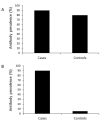Virus infections as potential targets of preventive treatments for type 1 diabetes
- PMID: 23804265
- PMCID: PMC3740695
- DOI: 10.1900/RDS.2012.9.260
Virus infections as potential targets of preventive treatments for type 1 diabetes
Abstract
Environmental factors play an important role in the pathogenesis of type 1 diabetes, and are attractive targets for preventive interventions. Several studies have shown that viruses can cause diabetes in animals, indicating their potential as candidates for environmental triggering agents. However, human studies have been hampered by the complex nature of the disease pathogenesis, leaving the question of viral etiology unanswered. Significant progress has recently been made in this field by searching for viruses within pancreatic tissue samples, and by carrying out prospective studies. Consequently, there is increasing evidence for a group of enteroviruses acting as possible environmental key triggers. In past studies, these viruses have been linked to type 1 diabetes. Recent studies have shown that they exert tropism to pancreatic islets, and that they are associated with the start of the beta-cell damaging process. Also, polymorphisms of the gene coding for the innate immune system sensor for enteroviruses (IFIH1) were found to modulate the risk of diabetes. Based on these findings, interest in the possible development of vaccines against these viruses has increased. However, even if enterovirus vaccines (polio vaccines) are effective and safe, we currently lack necessary information for the development of a vaccine against diabetogenic enteroviruses, e.g. regarding the identification of their specific serotypes and the causal relationship between these viruses and diabetes initiation. Ongoing research projects are currently addressing these questions, and will hopefully increase the consensus in this field. Also, new sequencing technologies will provide additional information about the whole virome, which could enable the discovery of new candidate viruses.
Figures



Similar articles
-
Enteroviruses in the pathogenesis of type 1 diabetes.Semin Immunopathol. 2011 Jan;33(1):45-55. doi: 10.1007/s00281-010-0207-y. Epub 2010 Apr 28. Semin Immunopathol. 2011. PMID: 20424841 Review.
-
Enteroviruses: new findings on the role of enteroviruses in type 1 diabetes.Int J Biochem Cell Biol. 2006;38(5-6):721-5. doi: 10.1016/j.biocel.2005.08.019. Epub 2005 Sep 27. Int J Biochem Cell Biol. 2006. PMID: 16226050
-
Role of enteroviruses in the pathogenesis of type 1 diabetes.Diabetologia. 2009 Jun;52(6):995-6. doi: 10.1007/s00125-009-1332-9. Epub 2009 Mar 26. Diabetologia. 2009. PMID: 19322560 No abstract available.
-
Enterovirus infections and type 1 diabetes.Ann Med. 2002;34(3):138-47. Ann Med. 2002. PMID: 12173683 Review.
-
Diabetes: A virus-gene collaboration.Nature. 2009 May 28;459(7246):518-9. doi: 10.1038/459518a. Nature. 2009. PMID: 19478773 No abstract available.
Cited by
-
Persistent coxsackievirus B1 infection triggers extensive changes in the transcriptome of human pancreatic ductal cells.iScience. 2021 Dec 18;25(1):103653. doi: 10.1016/j.isci.2021.103653. eCollection 2022 Jan 21. iScience. 2021. PMID: 35024587 Free PMC article.
-
The Environmental Determinants of Diabetes in the Young (TEDDY) Study: 2018 Update.Curr Diab Rep. 2018 Oct 23;18(12):136. doi: 10.1007/s11892-018-1113-2. Curr Diab Rep. 2018. PMID: 30353256 Free PMC article. Review.
-
Emerging Comorbidities in Adult Asthma: Risks, Clinical Associations, and Mechanisms.Mediators Inflamm. 2016;2016:3690628. doi: 10.1155/2016/3690628. Epub 2016 Apr 26. Mediators Inflamm. 2016. PMID: 27212806 Free PMC article. Review.
-
Coxsackievirus B Persistence Modifies the Proteome and the Secretome of Pancreatic Ductal Cells.iScience. 2019 Sep 27;19:340-357. doi: 10.1016/j.isci.2019.07.040. Epub 2019 Jul 29. iScience. 2019. PMID: 31404834 Free PMC article.
-
Vaccine for Diabetes-Where Do We Stand?Int J Mol Sci. 2022 Aug 22;23(16):9470. doi: 10.3390/ijms23169470. Int J Mol Sci. 2022. PMID: 36012735 Free PMC article. Review.
References
-
- Knip M, Veijola R, Virtanen SM, Hyoty H, Vaarala O, Akerblom HK. Environmental triggers and determinants of type 1 diabetes. Diabetes. 2005;54(Suppl 2):S125–S136. - PubMed
-
- Barboni E, Manocchio J. Alterazioni pancreatiche in bovini con diabete mellito post-aftoso. Arch Vet Ital. 1962;13:477–489.
-
- Jaidane H, Sane F, Gharbi J, Aouni M, Romond MB, Hober D. Coxsackievirus B4 and type 1 diabetes pathogenesis: contribution of animal models. Diabetes Metab Res Rev. 2009;25:591–603. - PubMed
-
- Tracy S, Drescher KM. Coxsackievirus infections and NOD mice: relevant models of protection from, and induction of, type 1 diabetes. Ann NY Acad Sci. 2007;1103:143–151. - PubMed
-
- Yoon JW, Jun HS. Viruses cause type 1 diabetes in animals. Ann NY Acad Sci. 2006;1079:138–146. - PubMed
Publication types
MeSH terms
LinkOut - more resources
Full Text Sources
Medical
Miscellaneous
